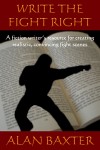 One of the things I am constantly at pains to get students and new writers to understand is the physics of your characters’ actions. That is: can they physically do what you’re telling the reader they are doing? He scratched his backside with his right hand, while tangoing across the room while also gripping his beautiful partner’s waist, also with the right hand.
One of the things I am constantly at pains to get students and new writers to understand is the physics of your characters’ actions. That is: can they physically do what you’re telling the reader they are doing? He scratched his backside with his right hand, while tangoing across the room while also gripping his beautiful partner’s waist, also with the right hand.
What I challenge folk to do is to write it down, then attempt to do it yourself – if you end up putting your back out or breaking your Mum’s best china, then chances are your physics of action is off.
Nowhere is this more obvious than in fight scenes – well, except maybe in sex scenes and it’s best if I don’t start on those. If you’re offended by the word ‘arse’ above, imagine what I can do with all the words involved in a sex scene.
What’s my point? My point is Alan Baxter. On fight scenes and how to do them properly. I threatened Al until he wrote something for me and it is below. Obviously, I can offer no real physical threat but I can talk at him for an extended period and that is enough to scare the toughest of tough and manly men. Here is his wisdom:
You know when you read a book and a love scene spoils the story because the writer isn’t nearly the lover they think their character is? Or when you read a science fiction story you’re really enjoying, then the science suddenly becomes ridiculous and spoils everything? (I’m looking at you, Red Matter.)
For me, it’s like that with fight scenes. Pretty much every book or story with any kind of action will, at some point, involve a fight. And most writers, thankfully, have never had a fight in their lives. So when they write fight scenes they draw on the only experience they do have, which is television and movies. It’s a bit like virgin romance writers using gonzo porn for inspiration. (Not that I’ve ever watched gonzo porn or anything. Or anything. But you know what I mean.)
I’m fairly unique in being a writer who has fought, a lot. (Though I keep finding others like me. There are more than you might imagine. Be afraid.) I’m a martial arts instructor and have been involved with fighting in one form or another for around thirty years. Of course, the vast majority of people aren’t nearly so picky as me. You can get stuff past other people who haven’t fought, because they don’t know any better than you do. But a really well-written, visceral fight scene will impress people even though they can’t necessarily tell you why.
For example, if someone gets punched hard in the face, they’ll collapse in terrible pain, completely stunned and may even curl up in a foetal ball of terror. If they’re not already unconscious. They won’t narrow their eyes and wipe a single drop of blood from their lip. A really good punch in the face is a devastating thing.
Even if a person has fought a lot, one good, solid hit is a fight ender. It’s the KO boxers and the like are always looking for. And it’s bloody hard to land. Especially against someone who doesn’t want to be hit. Double especially if that someone has any training.
If you have a scene in your fiction in which someone gets hit and reacts in the first way I described, your readers will have a sudden and visceral moment of reality. They’ll respect your understanding of your subject. Just like SF fans respect the research that goes into quality science fiction writing, even if they themselves aren’t astro-physicists. It’s our job, as writers, to get this stuff right as much as we can.
Have a think about it and don’t propagate the terrible, unrealistic choreographed fighting we see on screen. That often works for screen, but film is a very limited medium, even with all the special effects and everything else. As writers we have so much more to draw on, so much scope for detail that can’t be seen on film, and so much opportunity to improve on Hollywood. We owe it to our readers.
Want to know more? I can only urge you to check out Al’s book and a truly handy resource: Write the Fight.



13 Responses to Kapow! Thwack! Zok!